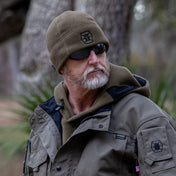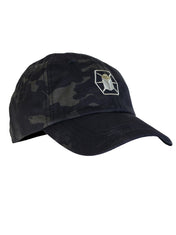Camouflage is a pattern of paradox. Camouflage’s history includes both hiding but also being seen, confusing the eye and subverting reality.
Since the 1850s, military units around the world have embraced the concept of camouflage to help obscure the visibility and movement of their troops by enemy forces.
The concept of camouflage was used first by the British when they abandoned their own bright red coats in favor of khaki uniforms in India, which blended more easily into the landscape.
The word "camouflage" is derived from a French expression meaning "puffing smoke."
Here are some of our favorites.
MultiCam® is a camouflage pattern designed for use in a wide range of environments and conditions. As a result of the pattern’s effectiveness across many environments and regions, it has been widely adopted globally.
First unveiled in 2002, MultiCam® was designed for the use of the U.S. Army operating in varied environments, seasons, elevations, and light conditions. It is a seven-color, multi-environment camouflage pattern developed by Crye Precision in conjunction with United States Army Soldier Systems Center.
MultiCam® Black was also created by Crye Precision and designed specifically to stand out. Released in 2013, the design is meant to impose and project authority. Multicam Black was created to expand the lineup into the field of law enforcement and to make military special forces units distinctly identifiable.
Kryptek was created in 2010 by U.S. Army pilots Butch Whiting and Josh Cleghorn, the founders of Kryptek Outdoor Group. The company was created to develop camouflage patterns for gear and clothing that can be used both for hunting and on the battlefield. The Kryptek pattern is available in many different color combinations for a variety of different environments and situations. The name Kryptek is a combination of two Greek words: Kryptos, meaning hidden, and Technos, meaning technologies.
PenCott® uses a 3-in-1 pattern geometry and it encompasses some aspects of the pixelated digital patterns seen in MARPAT, UCP, CADPAT and other digital camouflage patterns. It breaks up those small squares of color with organic elements that appear more natural, providing solid concealment at close, medium and long ranges. Inspired by his lifelong interest in camouflage, creator Dom Hyde of Hyde Definition first started working on its creation in 2005. This camouflage pattern is named after two British camouflage pioneers, Sir Roland Penrose and Dr. Hugh Cott.
Civilian Wear
Camouflage first emerged in the civilian wardrobe in the late 1960s as part of the counterculture appropriation of military surplus clothing for street wear - an ironic response to the Vietnam War. The trend faded but then resumed in the 1980s and again the 1990s. Today, camouflage is present in many fashion designers’ collections.
Interested in camo tactical apparel? Check out Kitanica camouflage tactical pants, shorts and shirts, including Multicam®, Multicam® Black, Kryptek and PenCott®.
Sources:
https://www.historyextra.com/period/victorian/a-brief-history-of-camouflage/
https://fashion-history.lovetoknow.com/fabrics-fibers/camouflage-cloth



